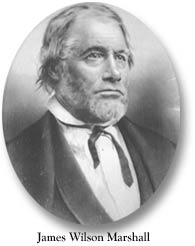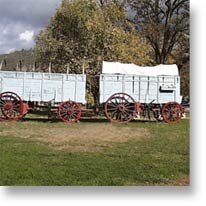|

James
Marshall was forced to leave his home in Missouri
because of illness. He arrived at Sutter's Fort in
California, July 1845, and was immediately hired by
Captain John A. Sutter as a carpenter. He left
Sutter to serve with the American forces and after
serving just over a year returned to work for
Sutter. It was then James Marshall was asked to
find a location in the mountains to build a sawmill
so John Sutter would have enough lumber to expand
his agricultural empire, "New Helvetia" in the
Sacramento Valley. On a river created by snow
melting in the High Sierra and winding it's way
through the Cullumah Valley, (Coloma) Marshall
selected the site to build the mill. In September
1847, along with some of Sutter's workmen, Marshall
left for the hills to start construction of the
mill. Construction was completed within the year
but a problem arose. The tailrace that
carried
 water
away from the mill was too shallow and needed to be
deepened. While inspecting the tailrace, Marshall
spotted some shining flecks in the water. After
briefly inspecting the substance he announced his
find to the others stating , "Boys, by God, I
believe I have found a gold mine." After further
inspection by various tests it was believed the
substance was indeed gold. Marshall took his find
to Sutter where Sutter did even more testing and
confirmed Marshall's conclusion. January 24, 1848,
the day Marshall discovered gold and changed the
course of California's history. Word of the
discovery spread and it wasn't long before gold
fever infected nearly everyone. People from all
over the world wanted to travel to California and
strike it rich. water
away from the mill was too shallow and needed to be
deepened. While inspecting the tailrace, Marshall
spotted some shining flecks in the water. After
briefly inspecting the substance he announced his
find to the others stating , "Boys, by God, I
believe I have found a gold mine." After further
inspection by various tests it was believed the
substance was indeed gold. Marshall took his find
to Sutter where Sutter did even more testing and
confirmed Marshall's conclusion. January 24, 1848,
the day Marshall discovered gold and changed the
course of California's history. Word of the
discovery spread and it wasn't long before gold
fever infected nearly everyone. People from all
over the world wanted to travel to California and
strike it rich.
 By
June of 1849 some 80,000 pioneers and speculators
had converged on the newly discovered Gold fields.
Among those displaced in this deluge of fortune
seekers where the Nisenan people who had for
centuries called the Cullumah Valley and the
Cullomain Village their home. By
June of 1849 some 80,000 pioneers and speculators
had converged on the newly discovered Gold fields.
Among those displaced in this deluge of fortune
seekers where the Nisenan people who had for
centuries called the Cullumah Valley and the
Cullomain Village their home.
On February 18, 1850 El
Dorado County was created with Coloma selected as
the first county seat. Only 7 months later
California became the 31st state in the union. In
1854 the county seat was moved to Placerville where
it has remained for 150 years.

In May of 1980 a monument
honoring James Marshall was erected on a hill above
his burial site. The bronze-coated statue, cast in
San Francisco, depicts Marshall pointing to the
spot he discovered Gold and changed the world
forever!
|



 water
away from the mill was too shallow and needed to be
deepened. While inspecting the tailrace, Marshall
spotted some shining flecks in the water. After
briefly inspecting the substance he announced his
find to the others stating , "Boys, by God, I
believe I have found a gold mine." After further
inspection by various tests it was believed the
substance was indeed gold. Marshall took his find
to Sutter where Sutter did even more testing and
confirmed Marshall's conclusion. January 24, 1848,
the day Marshall discovered gold and changed the
course of California's history. Word of the
discovery spread and it wasn't long before gold
fever infected nearly everyone. People from all
over the world wanted to travel to California and
strike it rich.
water
away from the mill was too shallow and needed to be
deepened. While inspecting the tailrace, Marshall
spotted some shining flecks in the water. After
briefly inspecting the substance he announced his
find to the others stating , "Boys, by God, I
believe I have found a gold mine." After further
inspection by various tests it was believed the
substance was indeed gold. Marshall took his find
to Sutter where Sutter did even more testing and
confirmed Marshall's conclusion. January 24, 1848,
the day Marshall discovered gold and changed the
course of California's history. Word of the
discovery spread and it wasn't long before gold
fever infected nearly everyone. People from all
over the world wanted to travel to California and
strike it rich. By
June of 1849 some 80,000 pioneers and speculators
had converged on the newly discovered Gold fields.
Among those displaced in this deluge of fortune
seekers where the Nisenan people who had for
centuries called the Cullumah Valley and the
Cullomain Village their home.
By
June of 1849 some 80,000 pioneers and speculators
had converged on the newly discovered Gold fields.
Among those displaced in this deluge of fortune
seekers where the Nisenan people who had for
centuries called the Cullumah Valley and the
Cullomain Village their home.